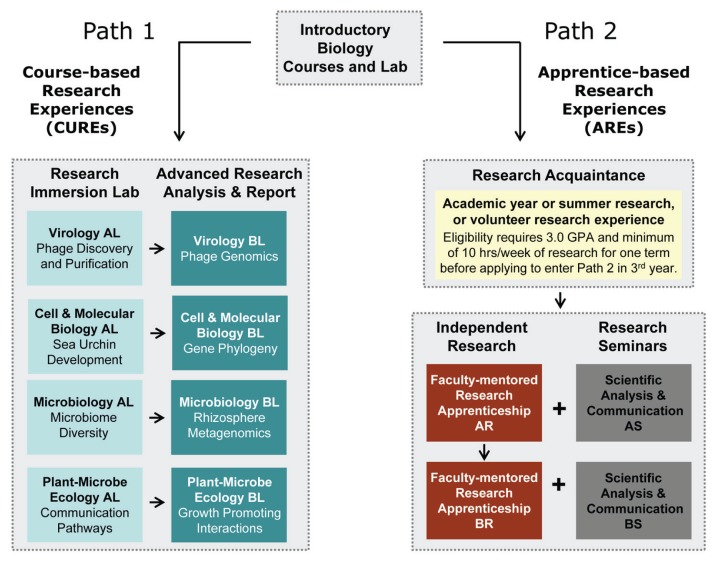This four-year research describes the evaluation of a bifurcated laboratory curriculum designed to offer upper-division undergraduate majors in two life science departments significant publicity to genuine analysis. The timing is crucial because it gives a pathway for each immediately admitted and switch college students to enter analysis.
To fulfill their diploma necessities, all majors full one of two paths in the laboratory program. One path immerses college students in scientific discovery skilled by means of workforce analysis initiatives (course-based undergraduate analysis experiences, or CUREs) and the different path by means of a mentored, impartial analysis venture (apprentice-based analysis experiences, or AREs). The bifurcated laboratory curriculum was structured utilizing backwards design to assist all college students, irrespective of path, obtain particular studying outcomes. Over 1,000 undergraduates enrolled in the curriculum.
Self-report survey outcomes point out that there have been no important variations in affective positive aspects by path. Students conveyed which elements of the curriculum have been crucial to their studying and improvement of research-oriented expertise. Students’ pursuits in biology elevated upon completion of the curriculum, inspiring a subset of CURE individuals to subsequently pursue additional analysis.
A rubric-guided efficiency analysis, employed to immediately measure studying, revealed variations in studying positive aspects for CURE versus ARE individuals, with proof suggesting a CURE can cut back the achievement hole between high-performing college students and their friends.

Catalyzing speedy discovery of gold-precipitating bacterial lineages with college college students.
Intriguing and probably commercially helpful microorganisms are discovered in our environment and new instruments enable us to find out about their genetic potential and evolutionary historical past. Engaging college students from completely different disciplines and programs in the seek for microbes requires an thrilling venture with progressive however simple procedures and targets.
Here we describe an interdisciplinary program to have interaction college students from completely different programs in the sampling, identification and evaluation of the DNA sequences of a distinctive but widespread microbe, Delftia spp.
A campus-wide problem was created to determine the prevalence of this genus, capable of precipitate gold, involving introductory degree environmental and life science programs, upper-level superior laboratory modules taken by undergraduate college students (juniors and seniors), graduate college students and workers from the campus.
The quantity of individuals concerned allowed for intensive sampling whereas undergraduate researchers and college students in lab-based programs participated in the pattern processing and analyses, serving to contextualize and solidify their studying of the molecular biology methods. The outcomes have been shared at every step by means of publicly accessible web sites and workshops.
This mannequin permits for the speedy discovery of Delftia presence and prevalence and is adaptable to completely different campuses and experimental questions.
